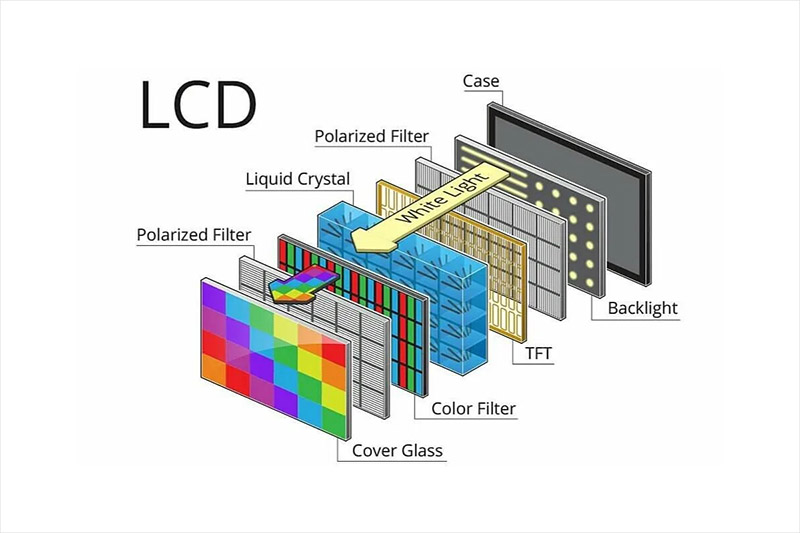- English
- Español
- Português
- русский
- Français
- 日本語
- Deutsch
- tiếng Việt
- Italiano
- Nederlands
- ภาษาไทย
- Polski
- 한국어
- Svenska
- magyar
- Malay
- বাংলা ভাষার
- Dansk
- Suomi
- हिन्दी
- Pilipino
- Türkçe
- Gaeilge
- العربية
- Indonesia
- Norsk
- تمل
- český
- ελληνικά
- український
- Javanese
- فارسی
- தமிழ்
- తెలుగు
- नेपाली
- Burmese
- български
- ລາວ
- Latine
- Қазақша
- Euskal
- Azərbaycan
- Slovenský jazyk
- Македонски
- Lietuvos
- Eesti Keel
- Română
- Slovenski
- मराठी
- Srpski језик
From liquid crystal molecules to color presentation in liquid crystal modules
2024-06-04
With the continuous development of technology, we are also exposed to more and more electronic products in our daily lives. LCD screens have become a very common type of screen in electronic products such as mobile phones, televisions, and computers. So, how does the LCD module achieve display? This article will introduce the display principle of LCD modules to you.
1、 The arrangement of liquid crystal molecules
The liquid crystal molecules in the liquid crystal module are key components that achieve image presentation by changing their own arrangement. Liquid crystal molecules are organic compounds with regular shapes and sizes. Liquid crystal molecules have two special properties: first, they have polarization and can only vibrate in specific directions; The second is that it can be influenced by an electric field.
There are two types of arrangement of liquid crystal molecules: nematic and twisted nematic. Nematic arrangement refers to the orderly arrangement of liquid crystal molecules on the liquid crystal surface, forming a long "columnar" structure, and the molecules are arranged very orderly along the direction of the "columnar" structure. Twisted nematic type refers to the twisted arrangement of liquid crystal molecules at the liquid crystal level, resulting in different angles in the arrangement direction of liquid crystal molecules at different positions.

2、 The role of electric field
The display principle of liquid crystal modules is to use the effect of an electric field to change the arrangement of liquid crystal molecules, thereby achieving the presentation of images. Specifically, when the electric field intensity in the liquid crystal module changes, the arrangement of liquid crystal molecules will also change accordingly.
In the absence of an electric field, the direction of nematic liquid crystal molecules is parallel to the liquid crystal plane, while the direction of twisted nematic liquid crystal molecules is helical. When the direction of the electric field is the same as that of the liquid crystal molecule, the influence of the electric field on the liquid crystal molecule is minimal; When the direction of the electric field is perpendicular to the direction of the liquid crystal molecule, the electric field has the greatest impact on the liquid crystal molecule. Therefore, as the electric field strength increases, the arrangement of liquid crystal molecules will gradually change, ultimately presenting different states.
3、 Color presentation
In the LCD module, each pixel has three primary colors: red, green, and blue. By controlling the brightness and combination of three primary colors for each pixel, various colors can be presented.
Each pixel of the LCD module is clamped by two plates and filled with LCD molecules. By adding an appropriate amount of liquid crystal molecules in the space between the plates, the arrangement of the liquid crystal molecules can control the propagation of light in the liquid crystal module.
When the arrangement of liquid crystal molecules changes, the polarization state of the liquid crystal molecules towards the incident light also changes. By controlling the intensity and direction of the electric field, the LCD module can control the polarization state of the incident light, thereby controlling the degree and direction of light transmission in the LCD module, and ultimately presenting the desired image.
The optical components in the LCD module also include a backlight and a color filter. Backlight can provide backlight for displaying images. Color filters can filter the wavelength of light, only passing through the desired red, green, and blue colors.
4、 Summary
In summary, the display principle of liquid crystal modules is to control the arrangement of liquid crystal molecules, utilize the influence of electric field on the polarization state of light, and control the degree and direction of light transmission in the liquid crystal module,




